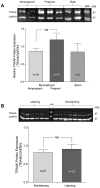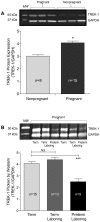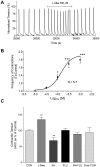Expression of stretch-activated two-pore potassium channels in human myometrium in pregnancy and labor
- PMID: 20811500
- PMCID: PMC2928262
- DOI: 10.1371/journal.pone.0012372
Expression of stretch-activated two-pore potassium channels in human myometrium in pregnancy and labor
Abstract
Background: We tested the hypothesis that the stretch-activated, four-transmembrane domain, two pore potassium channels (K2P), TREK-1 and TRAAK are gestationally-regulated in human myometrium and contribute to uterine relaxation during pregnancy until labor.
Methodology: We determined the gene and protein expression of K2P channels in non-pregnant, pregnant term and preterm laboring myometrium. We employed both molecular biological and functional studies of K2P channels in myometrial samples taken from women undergoing cesarean delivery of a fetus.
Principal findings: TREK-1, but not TREK-2, channels are expressed in human myometrium and significantly up-regulated during pregnancy. Down-regulation of TREK-1 message was seen by Q-PCR in laboring tissues consistent with a role for TREK-1 in maintaining uterine quiescence prior to labor. The TRAAK channel was unregulated in the same women. Blockade of stretch-activated channels with a channel non-specific tarantula toxin (GsMTx-4) or the more specific TREK-1 antagonist L-methionine ethyl ester altered contractile frequency in a dose-dependent manner in pregnant myometrium. Arachidonic acid treatment lowered contractile tension an effect blocked by fluphenazine. Functional studies are consistent with a role for TREK-1 in uterine quiescence.
Conclusions: We provide evidence supporting a role for TREK-1 in contributing to uterine quiescence during gestation and hypothesize that dysregulation of this mechanism may underlie certain cases of spontaneous pre-term birth.
Conflict of interest statement
Figures






Similar articles
-
Adaptive reduction of human myometrium contractile activity in response to prolonged uterine stretch during term and twin pregnancy. Role of TREK-1 channel.Biochem Pharmacol. 2018 Jun;152:252-263. doi: 10.1016/j.bcp.2018.03.021. Epub 2018 Mar 22. Biochem Pharmacol. 2018. PMID: 29577872 Free PMC article.
-
A role of stretch-activated potassium currents in the regulation of uterine smooth muscle contraction.Acta Pharmacol Sin. 2011 Jun;32(6):758-64. doi: 10.1038/aps.2011.62. Acta Pharmacol Sin. 2011. PMID: 21642947 Free PMC article. Review.
-
The stretch-dependent potassium channel TREK-1 and its function in murine myometrium.J Physiol. 2011 Mar 1;589(Pt 5):1221-33. doi: 10.1113/jphysiol.2010.203869. Epub 2011 Jan 10. J Physiol. 2011. PMID: 21224218 Free PMC article.
-
TREK-1 currents in smooth muscle cells from pregnant human myometrium.Am J Physiol Cell Physiol. 2013 Sep 15;305(6):C632-42. doi: 10.1152/ajpcell.00324.2012. Epub 2013 Jun 26. Am J Physiol Cell Physiol. 2013. PMID: 23804201 Free PMC article.
-
Stretch-activated potassium currents in the heart: Focus on TREK-1 and arrhythmias.Prog Biophys Mol Biol. 2017 Nov;130(Pt B):223-232. doi: 10.1016/j.pbiomolbio.2017.05.005. Epub 2017 May 16. Prog Biophys Mol Biol. 2017. PMID: 28526352 Review.
Cited by
-
Much more than a leak: structure and function of K₂p-channels.Pflugers Arch. 2015 May;467(5):867-94. doi: 10.1007/s00424-015-1703-7. Epub 2015 Mar 21. Pflugers Arch. 2015. PMID: 25791628 Review.
-
Adaptive reduction of human myometrium contractile activity in response to prolonged uterine stretch during term and twin pregnancy. Role of TREK-1 channel.Biochem Pharmacol. 2018 Jun;152:252-263. doi: 10.1016/j.bcp.2018.03.021. Epub 2018 Mar 22. Biochem Pharmacol. 2018. PMID: 29577872 Free PMC article.
-
Kv7 and Kv11 channels in myometrial regulation.Exp Physiol. 2014 Mar;99(3):503-9. doi: 10.1113/expphysiol.2013.075754. Epub 2013 Oct 11. Exp Physiol. 2014. PMID: 24121285 Free PMC article. Review.
-
Altered expression and modulation of the two-pore-domain (K2P) mechanogated potassium channel TREK-1 in overactive human detrusor.Am J Physiol Renal Physiol. 2017 Aug 1;313(2):F535-F546. doi: 10.1152/ajprenal.00638.2016. Epub 2017 May 24. Am J Physiol Renal Physiol. 2017. PMID: 28539337 Free PMC article.
-
Multiple pregnancies, the myometrium and the role of mechanical factors in the timing of labour.Curr Res Physiol. 2023 Aug 24;6:100105. doi: 10.1016/j.crphys.2023.100105. eCollection 2023. Curr Res Physiol. 2023. PMID: 38107788 Free PMC article.
References
-
- WHO . World Health Organization Reports; 2001. The World Health Report 2001: mental health- new understanding, new hope.
-
- ACOG ACOG practice bulletin.Management of preterm labor.Number 43,May 2003. IntJGynaecolObstet. 2003;82:127–135. - PubMed
-
- Hogue CJ, Bremner JD. Stress model for research into preterm delivery among black women. American Journal of Obstetrics and Gynecology. 2005;192:S47–S55. - PubMed
Publication types
MeSH terms
Substances
Grants and funding
LinkOut - more resources
Full Text Sources
Medical

